Further seek safety, security, and satisfaction
(Initiatives Example)
Initiative guidelines
Based on the belief that safety and security are the backbone ofour Group’s businesses, we will strive to improve customersatisfaction through measures to address stakeholderexpectations, including planned investment in safety andconducting safety education and BCP training. Going forward,we will also strategically proceed with our response to naturaldisasters, which are expected to become even more severe.
Ensuring safety in our railway business and other businesses
Safety management in the railway business
Establishment of a safety policy, along with a system for business activities that has safety as its highest priority
On October 1, 2006, we established a “Safety Policy”*1 and are striving to develop a system for business activities based on the principle of having safety as the top priority. Furthermore, we also make efforts for the comprehensive use of railway facilities, railroad cars, and employees to ensure transportation safety.
Safety Policy
1.We will work together to prevent accidents, with safety as our top priority.
2.We comply with all laws and regulations related to transportation safety and perform our duties in a strict and dedicated manner.
3.All necessary confirmations will be performed and the handling method that is considered to be the safest will be conducted within the course of our work.
4.In the event of an accident or disaster, we will accomplish with saving lives as the top priority, and swiftly take safe and appropriate measures.
5.We will operate our safety management system appropriately and make efforts for constant improvement.
Establishment of a safety management system led by the President
We strive to “promote the mentality of safety first” and “cultivate a culture of safety” throughout the company, mainly through the regularly scheduled Safety Promotion Committee (headed by the President) and the monthly Safety Promotion Executive Committee (headed by the Comprehensive Safety Administration Manager). The heads of business management divisions for management strategies, human resources, and accounting also participate in the Safety Promotion Committee.
As the chief executive for safety management systems, the President appoints the Railway Business Division General Manager as the Comprehensive Safety Administration Manager, and the Railway Business & Train Stock Department Chief Manager as the Transportation Manager, establishing a safety management system by clarifying the roles to be played by those responsible for each relevant department. The “Safety Promotion Department” has been established as a department dedicated towards thoroughly ensuring safety and security. The Safety Promotion Department oversees matters related to the appropriate operation and improvement of safety management systems and coordinates with relevant departments to promote organization-wide efforts that are necessary to improve the safety and stability of transport.
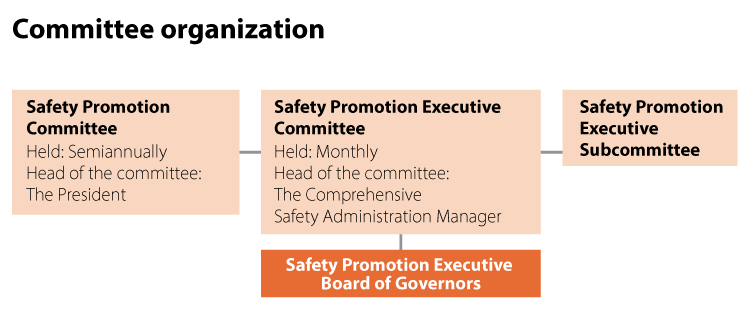
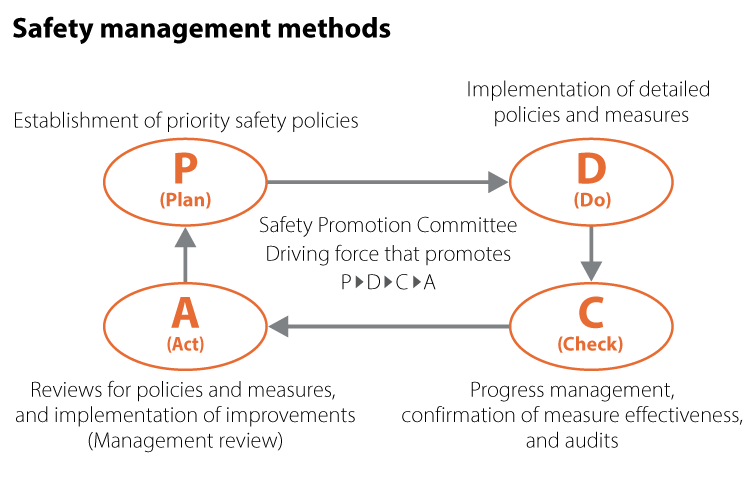
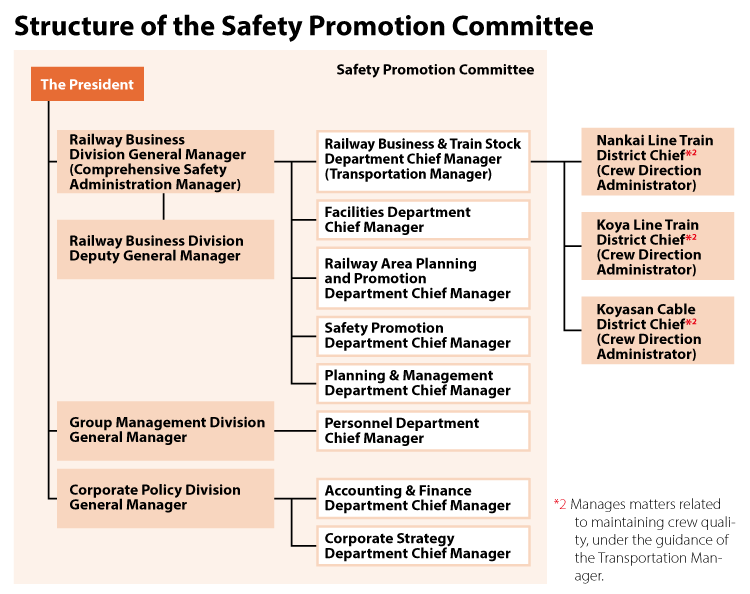
Transport safety management evaluation
In transport safety management evaluation, transport security inspectors working under the Director of Transport Safety of the Ministry of Land, Infrastructure, Transport and Tourism, and evaluation officers from local Transport Bureaus check our safety management status by interviewing our management, comprehensive safety administration managers, transportation managers, and other representatives of our business management division on our safety management system. The 8th transport safety management evaluation was conducted in September 2021 with no issues raised.
Priority safety policies
To resolve issues and ensure transport safety, we have established and worked on the following five items as key safety measures for FY2021.
Under our safety management system, we have also conducted management reviews based on the status of key safety measures and results from internal safety audits.
Priority safety policies for FY2021
1.Reduce natural disaster risks in accordance with the Transportation Disaster Management Guidelines
2.Increase safety of station platforms and crossings,including consideration of public requests
3.Increase safety through updates and reforms of old equipment and facilities
4.Change systems with safety equipment that utilizes digital technologies
5.Cultivate personnel and pass on skills for sustaining safety
Investments for safety
Continued capital investment for safety measures
We continue to conduct capital investments to systematically implement necessary safety measures without delay. Construction work for seismic reinforcement of elevated bridge columns and station buildings to prepare for large earthquakes that are predicted to occur in the future was conducted, along with measures to improve safety on station platforms and renewal of aging facilities. We will continue to make investments for the systematic promotion of safety measures in FY2022 as well.
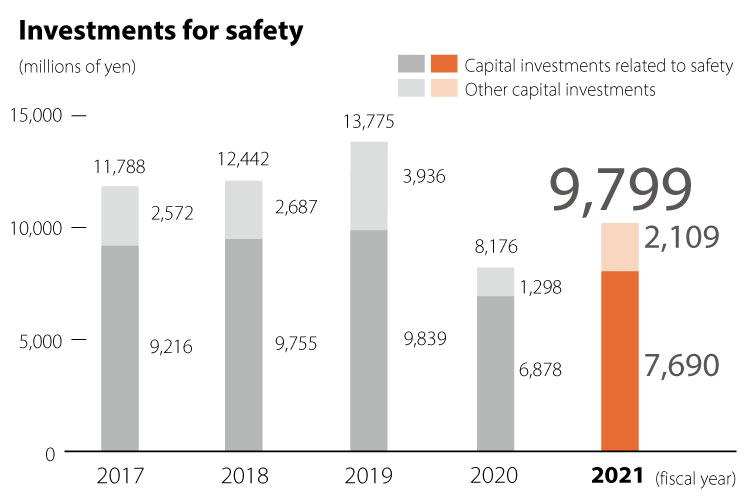
Major capital investments in 2021
Seismic reinforcement of elevated bridge columns (130 columns)
Continuous flyover roadway construction project
New 8300 series train cars (for 12 cars on the Koya Line)
9000 series car renewals (four cars)
Renewal of silicon rectifiers at substations (the Sayama Substation)
Renewal of switchboards (Fuke)
Renewal of block instruments
Status of railway operation accidents, transportation failures, and incidents
There were no major accidents (collisions, derailments, or fire) in this year.
・Two incidents occurred that were reported to the Kinki District Transport in FY2021.
・There was no administrative guidance given to our company.
Incidents

Occurrences in the past five years
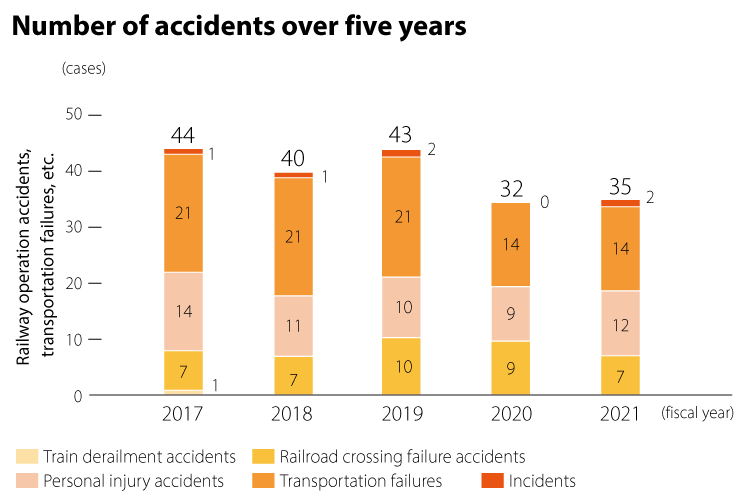
<Reference> Classification of railroad operation accidents, etc.
| Railroad | Major | Train collision accidents | Accidents where a train collided with or came into |
| Train derailment accidents | Accidents where a train was derailed | ||
| Train fire accidents | Accidents involving fires on trains | ||
| Railroad crossing failure accidents | Accidents where a train or vehicle collided with or | ||
| Personal injury accidents | Accidents that resulted in the death or injury of | ||
| Transportation failures | A situation in which trains are suspended or delayed | ||
| Incidents | A situation that has not caused an accident yet, | ||
Conducted Safety education
Conducted Comprehensive training for accident recovery annually
Every year, a “comprehensive training for accident recovery” is conducted in which all departments participate to rescue the injured, evacuate customers, and restore areas that have been damaged, based on a scenario of a large-scale accident or disaster. In FY2021, the training was conducted based on the scenario of “guiding customers from train cars to the nearest train station and restoring damaged facilities for a train that had stopped under the instructions of the Earthquake Early Warning System and had derailed due to the shaking of the earthquake.” Multiple training areas were set, and the information gathering and coordination were checked.
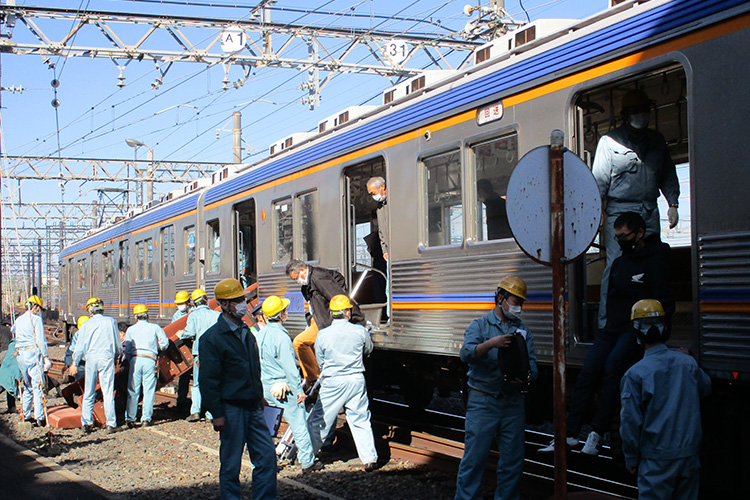
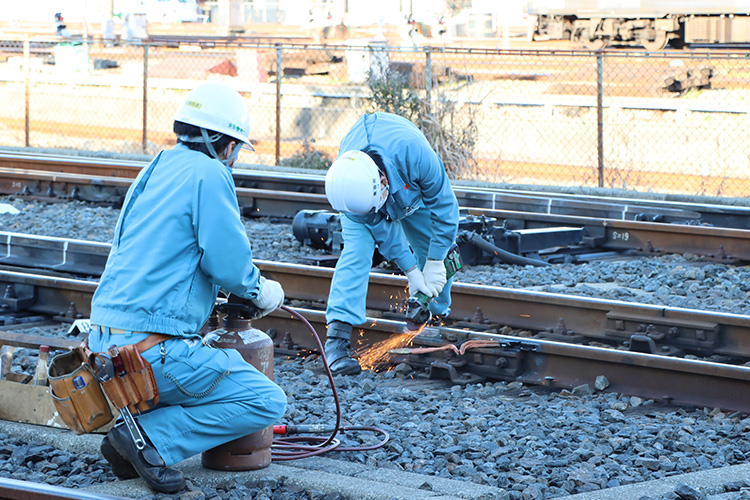
Joint training conducted with the police, etc., to be prepared for railway terrorism
We have worked with the police and other relevant organizations to conduct training to respond to attacks, such as potential attacks on trains and station platforms. In FY2021, training was conducted in Izumisano Station, Wakayamashi Station, and Namba Station, based on the scenario of responding to a person holding a knife on the train or platform by using protective shields, etc., while ensuring customer safety and then letting the police take over.
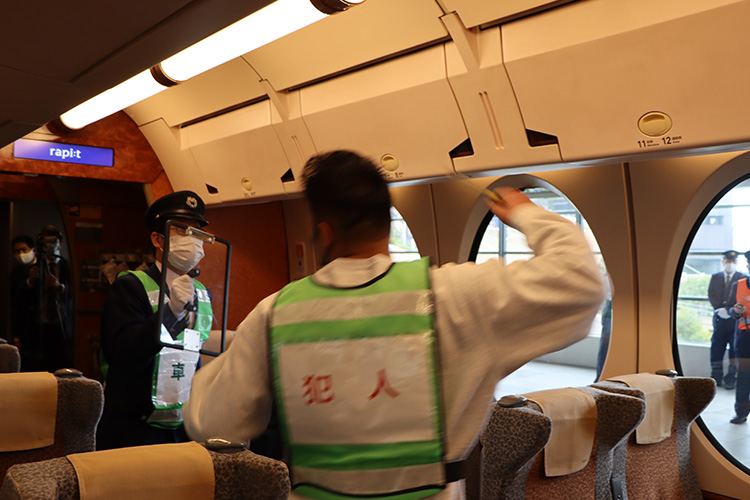
Evacuation and navigation training for a cable car
On the Kosaku Line, we conducted training based on a scenario that a fallen tree on the rails was blocking operation for hours and the staff had to guide passengers from the cable car to Koyasan Station.
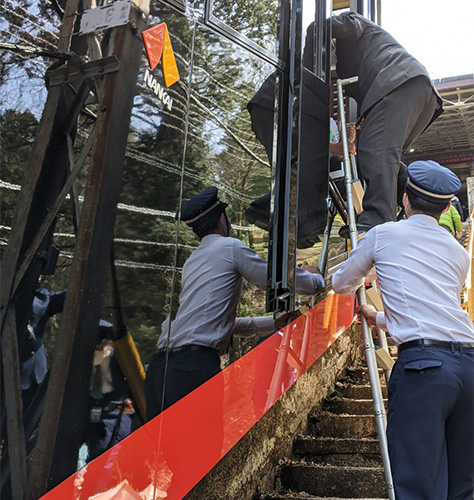
Improving safety awareness and safety levels
Safety awareness surveys
To quantitatively evaluate safety awareness and the level of understanding for the safety management system, we have been conducting a safety awareness survey every two years since FY2014. We have been raising our safety awareness and enhancing our safety management system by analyzing and evaluating FY2020 survey results and reflecting them in our safety measures.
Safety lectures
To raise employees’ safety awareness and to further enhance the initiatives to prevent accidents, we invite external lecturers every year to hold safety lectures. In FY2020, Toshiya Shiozaki from the Railway Technical Research Institute was invited as a lecturer to speak about matters that are truly important to ensure safety. The lecture was canceled in FY2021 due to the COVID-19 pandemic.
Railway Work Research Presentation
Every year, we hold a Railway Work Research Presentation to announce findings from the most excellent work research from our divisions. We shared results from the divisions, with a theme of spreading the awareness transformation initiative across the Railway Business Division through presentations about specific actions (operational improvements) taken to transform awareness. The lecture was canceled in FY2021 due to the COVID-19 pandemic.
Preparation for natural disasters, including risks arising from climate change
We are implementing various measures to reduce the increasing risk of natural disasters.
Systematic seismic reinforcement of overpass pillars and bridges
In preparation for the Nankai Trough Earthquake, we have systematically been working on the seismic reinforcement of structures. In FY2021, we completed seismic reinforcement for 130 overpass pillars.
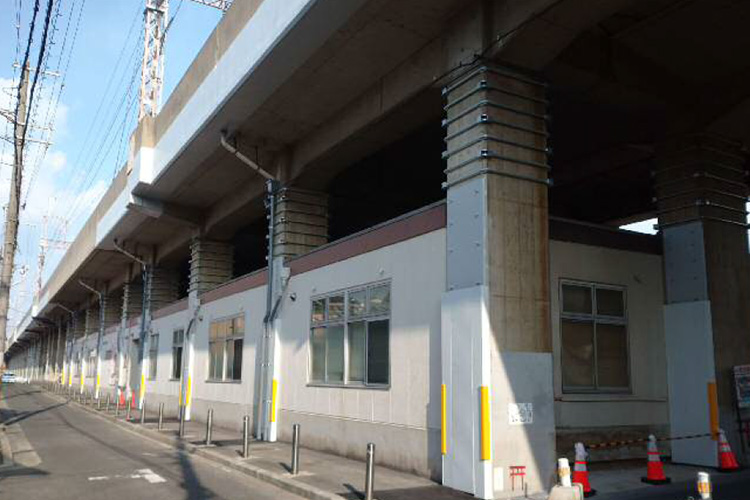
Taking measures to prevent bridge scours
Based on periodical inspection results, etc., we have been identifying bridges that are likely to be scoured and taking measures to prevent them based on the above results. In FY2021, we completed the scour protection construction of one bridge.
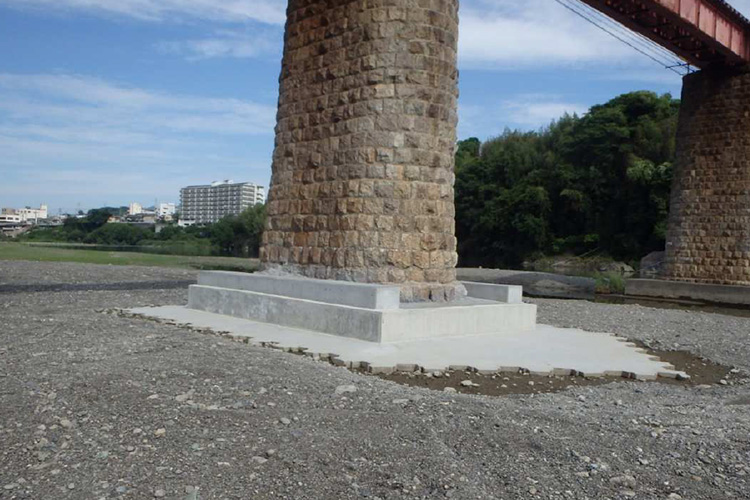
System to detect abnormalities in bridges
We developed a system to measure abnormalities in bridges with measuring instruments installed on the bridges, which will automatically turn on special signal light-emitting devices when abnormalities are detected, alerting train drivers and conductors immediately. By FY2021, we have installed this system at the Onosato River bridge, Kinokawa River bridge on the Koya Line, and Kinokawa River bridge on the Nankai Line. In FY2022, we plan to install this system at the Yamato River bridge on the Koya Line.
Adoption of Earthquake Early Warning System
We have adopted an Earthquake Early Warning System that directs all train drivers to stop in emergency when an earthquake is detected. Before tremors with seismic intensity of 5 Lower or above reach the areas along our railway lines, all train drivers are instructed automatically to perform an emergency stop to ensure train safety.
Measures taken to ensure customer safety during a tsunami
To respond to tsunamis after major earthquakes, we have listed the areas along our railway lines that could be flooded by tsunamis in a booklet, which has been distributed to stations and relevant workplaces and is carried by train staff.
Stations in evacuation areas (tsunami-inundated areas) announced by Osaka and Wakayama Prefectures display tsunami hazard maps and maps for evacuation areas and routes. There are also tsunami evacuation signboards installed in between stations in case trains stop, to help guide passengers to safe places before tsunamis arrive.
Dangerous trees are systematically cut down
To ensure safe operation, we systematically take measures against hazardous trees to reduce the increasing risk of natural disasters. We have tree doctors perform tree health examinations on trees in the areas along our railway lines between Hashimoto Station and Gokurakubashi Station, and cut down trees that are considered dangerous.
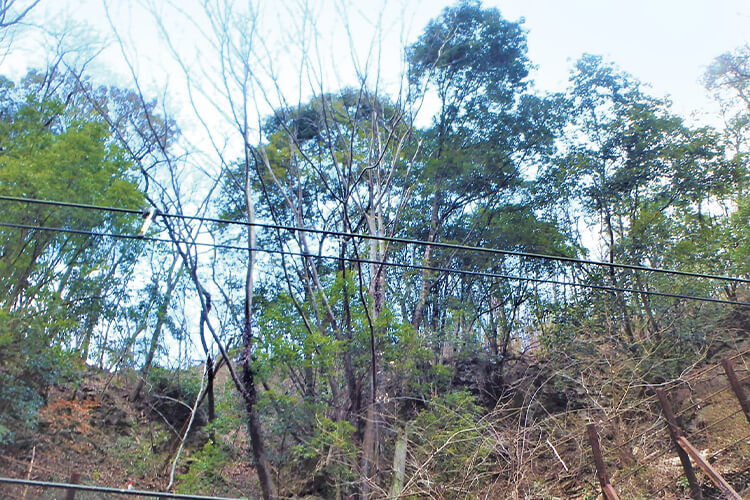
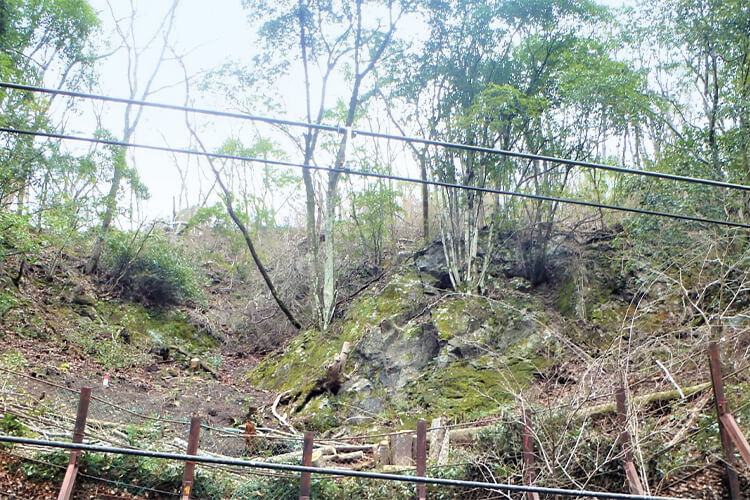
Disaster prevention information system
We have introduced a disaster prevention information system to collectively monitor weather information (such as rainfall, windspeed, and earthquakes) and railway-obstructing information (such as river levels).
Continuous flyover roadway construction
We have active discussions with relevant local governments and drive continuous flyover roadway constructions for the Nankai Line (in Sakai and Takaishi) and Takashinohama Line (in Takaishi) to abolish railroad crossings to improve operational security and resolve traffic jams. For the continuous flyover roadway constructions in Takaishi, the Nankai Line part was completed in May 2021. We will continue to work on the continuous flyover roadway constructions for the Takashinohama Line.
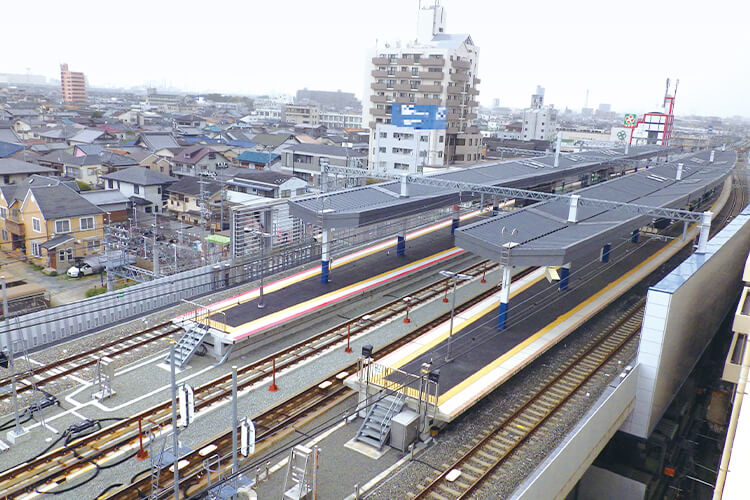
Employee label
We distribute employee labels to our employees so that when accidents and natural disasters such as earthquakes occur, off-duty employees who happen to be there (on the train, etc.) in their private attire can show others that they are our employees and engage in smooth support operations (checking who is injured, helping evacuation efforts, etc.).
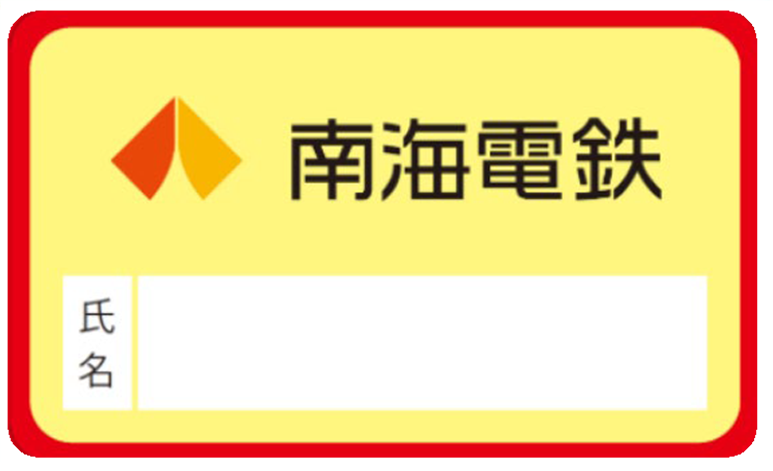
Providing safe and comfortable facilities and services
We believe that views and requests from customers are important management assets for us, so we use such information to improve our work and services. We continue to improve customer satisfaction, pursuing comfort and user-friendliness for all customers.
Providing safe facilities and services
Promotion of station restroom renewals
We have been making efforts to renovate station restrooms to provide better aesthetics, reduce odor with reinforced ventilation capacities, and enhance multi-functional toilets to make stations more comfortable to use. Four stations were renovated in FY2021.
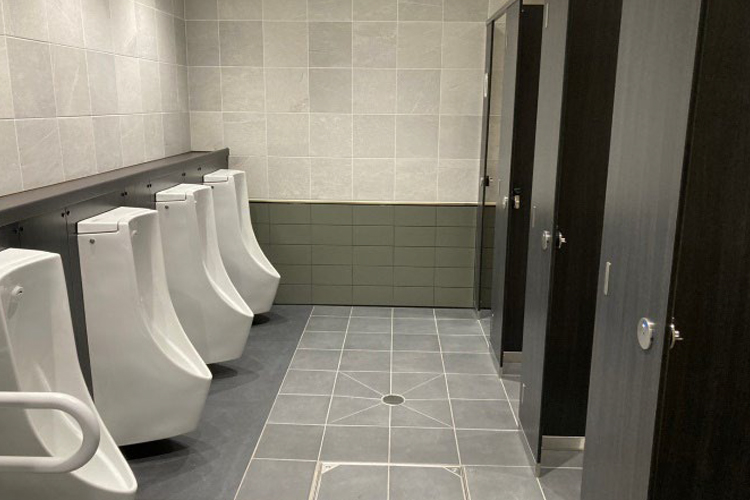
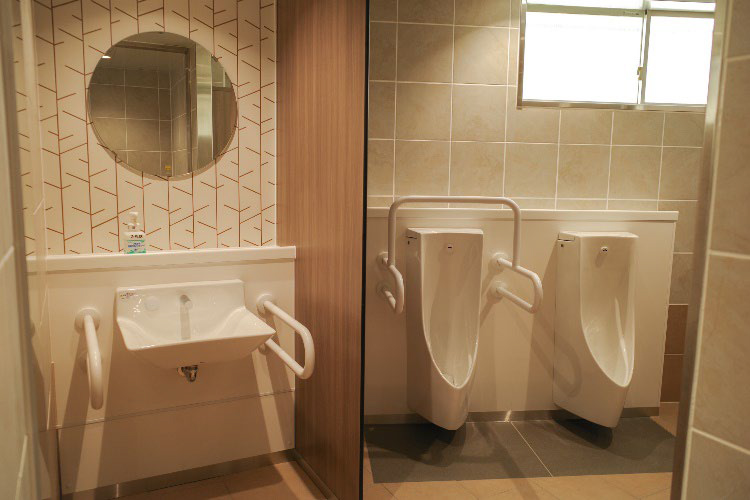
Promotion of barrier-free facilities
Barrier-free implementation status in stations
To make stations more accessible for all, we are installing barrier-free facilities in stations, such as slopes and elevators, and taking other measures. In FY2020, we installed two elevators on the Koya Line platform of Kishinosato-Tamade Station.
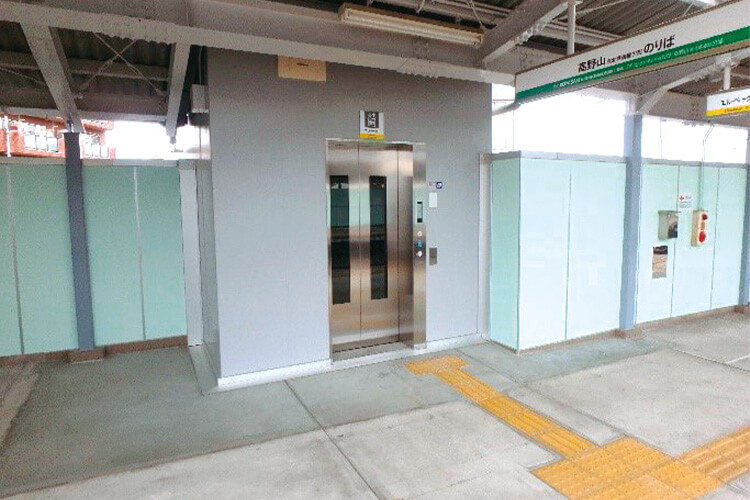
Barrier-free implementation status of our Group
At the “Aoki-shima no Yado Kumano-bettei Nakanoshima,” which is located in Nachikatsuura Town, Wakayama Prefecture, the new building “Naginosho” features accessible rooms. Furthermore, we have installed a slope at the restaurant “Dining Kumano-no-megumi” to ensure that as many customers as possible are able to visit the restaurant with peace of mind.

Creating safe and comfortable train interiors
we are also making efforts to provide greater safety and comfort by constructing new train cars and upgrading them. In FY2021, 12 new train cars for the 8300 series were constructed. The train cars are good for the environment and the people, with energy-efficient equipment, LED light fixtures, and in-train information displays in four languages. Furthermore, to prevent the spread of the COVID-19 virus, all train cars have undergone antiviral and antibacterial processing. We will continue to systematically create new cars and improve train cars.
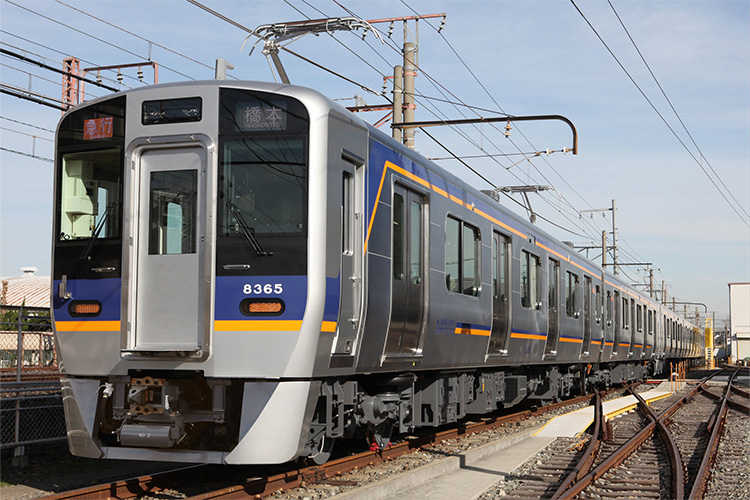
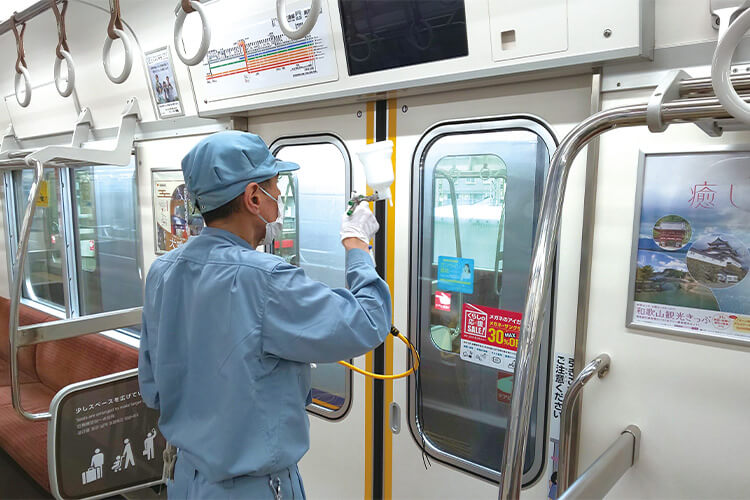
Developing employees with hospitality mindset
Conducting CS improvement training
We conduct various training to improve the skills of our employees in the railway division to respond to customers. Since FY2018, station staff have been learning through OJT on how to improve basic customer response and hospitality skills required at stations, how to respond to customers through role-playing, and how to make announcements when abnormalities are detected. We also continuously conduct training to improve our employees’ skills to respond to customers visiting Japan from abroad.
We also conduct CS improvement training for staff of the railway technology division and group company employees who are dealing with customers, to improve their customer response and hospitality skills.
Through these trainings, our employees learn not just hospitality and customer response skills, but also develop a hospitality mindset so that they can view situations from customers’ perspectives and act accordingly.
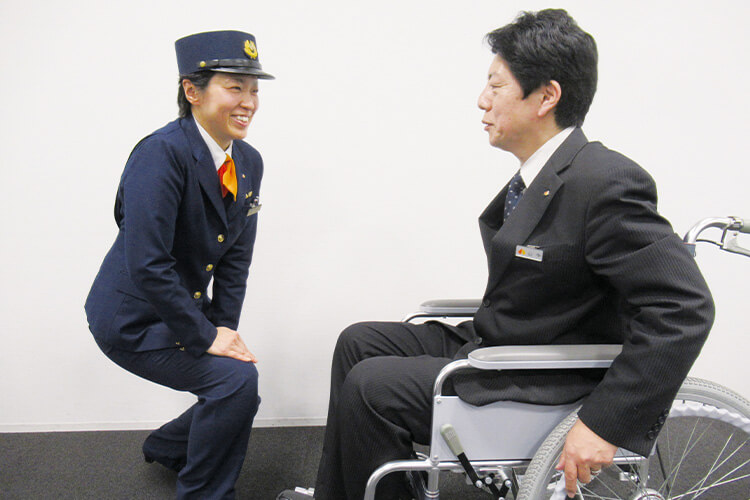
Encouraging staff to get Care-Fitter certifications
Since 2005, we have been encouraging station and railway zone assistants to get Care-Fitter certifications. As of August 2022, 321 employees have obtained the certification. Managers of the head office railway division, and heads of offices such as station managers have also attended basic Care-Fitter examination lectures to learn the skills needed to help people in need. Station and railway zone assistants who obtained Care-Fitter certifications have also passed on the support knowledge, techniques, and the barrier-free mindset that they have learned to station staff, train drivers, and conductors through operational training and OJT. We work together to improve our services so that all customers can use our services safely and securely.
Improving customer satisfaction by putting the customer’s perspective first
Grasping the level of customer satisfaction
Creating a database of customer voices
We recognize customer opinions and requests as important hints for our company management and use them to improve issues and services. Opinions, requests, and compliments from customers received through our website or received directly by employees are accumulated in our “Customer Voices” database. This content is published at our in-house network where employees can view them to improve operations and services. There were 2,326 customer voices received in FY2021.
Ranking of the FY2021 Customer Voices
Parentheses describe the number for the previous year.
| Cases | |||
|---|---|---|---|
| 1 | Customer services and hospitality | 526 | (552) |
| 2 | Manners of train passengers | 225 | (249) |
| 3 | Train timetables and schedule disruption | 142 | (130) |
| 4 | Railroad train cars | 133 | (52) |
| 4 | Railway tickets | 133 | (156) |
| 6 | In-car air conditioning | 128 | (159) |
| 7 | Station facilities | 109 | (162) |
| 8 | Railroad crossings | 24 | (40) |
| 9 | Webpage | 23 | (19) |
| 10 | Railroad track facilities | 6 | (12) |
Boosting the likability of the Nankai brand
The Nankai Group has “‘Nankaiine’ ga afureteru (To exude optimism for a better future)” as its brand slogan, to work on establishing the Nankai brand.
In August 2022, our official webpage was completely revamped to allow strategic information dissemination, with the aim of providing easy-to-understand site navigation and a unified design. Furthermore, we have been making efforts to improve the likability of our brand by widely communicating our sustainable initiatives to resolve various social issues as the “Hito Machi Mirai ‘Nankaii’ ACTION (Optimistic ACTION for the people, communities, and future)” to stakeholders.
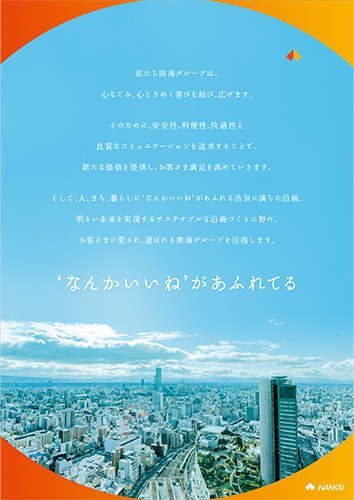
“‘なんかいいね’があふれてる”
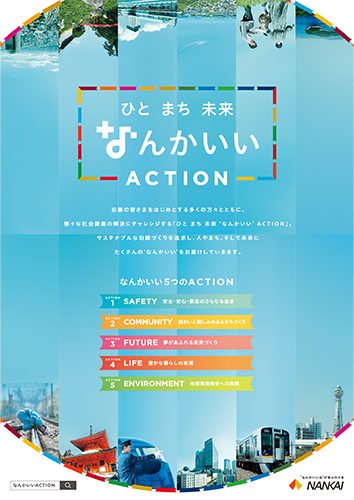
“ひとまち未来 ‘なんかいい’ ACTION”
Sustainability Site Map
(materiality)
- Major sustainability themes (materiality)
- Identification processes
- Further seek safety, security, and satisfaction
- Thriving and friendly community development
- Create a future full of dreams
- Achieve an enriched life
- Develop a workplace and staff in a way that enables each person to put their abilities to use
-
Contribute to preserving the global environment
- Environmental philosophy
- Reducing CO2 emissions in response to climate change, promoting the use of renewable energy, and so forth
- Bringing about a circular society
- Preserving biodiversity
- Deepening our environmental management
- Expanding environmental buildings (green buildings)
- Responses to TCFD Recommendations
- Bolster a corporate foundation that is sincere and fair
